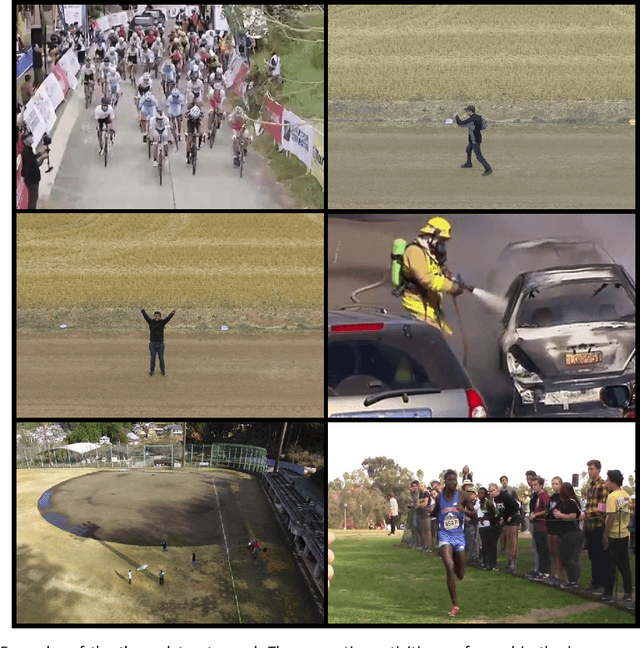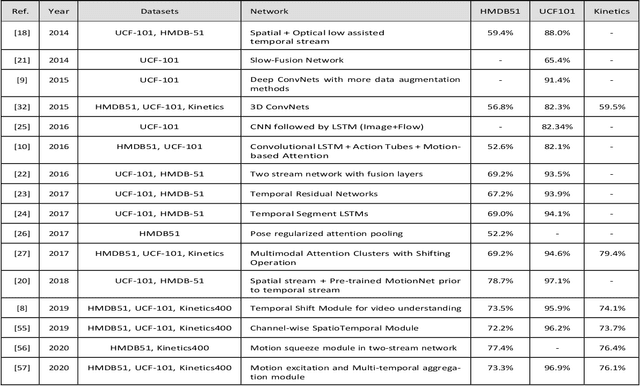Santosh Kumar Yadav
A Novel Two Stream Decision Level Fusion of Vision and Inertial Sensors Data for Automatic Multimodal Human Activity Recognition System
Jun 27, 2023Abstract:This paper presents a novel multimodal human activity recognition system. It uses a two-stream decision level fusion of vision and inertial sensors. In the first stream, raw RGB frames are passed to a part affinity field-based pose estimation network to detect the keypoints of the user. These keypoints are then pre-processed and inputted in a sliding window fashion to a specially designed convolutional neural network for the spatial feature extraction followed by regularized LSTMs to calculate the temporal features. The outputs of LSTM networks are then inputted to fully connected layers for classification. In the second stream, data obtained from inertial sensors are pre-processed and inputted to regularized LSTMs for the feature extraction followed by fully connected layers for the classification. At this stage, the SoftMax scores of two streams are then fused using the decision level fusion which gives the final prediction. Extensive experiments are conducted to evaluate the performance. Four multimodal standard benchmark datasets (UP-Fall detection, UTD-MHAD, Berkeley-MHAD, and C-MHAD) are used for experimentations. The accuracies obtained by the proposed system are 96.9 %, 97.6 %, 98.7 %, and 95.9 % respectively on the UP-Fall Detection, UTDMHAD, Berkeley-MHAD, and C-MHAD datasets. These results are far superior than the current state-of-the-art methods.
An Efficient Deep Convolutional Neural Network Model For Yoga Pose Recognition Using Single Images
Jun 27, 2023Abstract:Pose recognition deals with designing algorithms to locate human body joints in a 2D/3D space and run inference on the estimated joint locations for predicting the poses. Yoga poses consist of some very complex postures. It imposes various challenges on the computer vision algorithms like occlusion, inter-class similarity, intra-class variability, viewpoint complexity, etc. This paper presents YPose, an efficient deep convolutional neural network (CNN) model to recognize yoga asanas from RGB images. The proposed model consists of four steps as follows: (a) first, the region of interest (ROI) is segmented using segmentation based approaches to extract the ROI from the original images; (b) second, these refined images are passed to a CNN architecture based on the backbone of EfficientNets for feature extraction; (c) third, dense refinement blocks, adapted from the architecture of densely connected networks are added to learn more diversified features; and (d) fourth, global average pooling and fully connected layers are applied for the classification of the multi-level hierarchy of the yoga poses. The proposed model has been tested on the Yoga-82 dataset. It is a publicly available benchmark dataset for yoga pose recognition. Experimental results show that the proposed model achieves the state-of-the-art on this dataset. The proposed model obtained an accuracy of 93.28%, which is an improvement over the earlier state-of-the-art (79.35%) with a margin of approximately 13.9%. The code will be made publicly available.
DroneAttention: Sparse Weighted Temporal Attention for Drone-Camera Based Activity Recognition
Dec 07, 2022



Abstract:Human activity recognition (HAR) using drone-mounted cameras has attracted considerable interest from the computer vision research community in recent years. A robust and efficient HAR system has a pivotal role in fields like video surveillance, crowd behavior analysis, sports analysis, and human-computer interaction. What makes it challenging are the complex poses, understanding different viewpoints, and the environmental scenarios where the action is taking place. To address such complexities, in this paper, we propose a novel Sparse Weighted Temporal Attention (SWTA) module to utilize sparsely sampled video frames for obtaining global weighted temporal attention. The proposed SWTA is comprised of two parts. First, temporal segment network that sparsely samples a given set of frames. Second, weighted temporal attention, which incorporates a fusion of attention maps derived from optical flow, with raw RGB images. This is followed by a basenet network, which comprises a convolutional neural network (CNN) module along with fully connected layers that provide us with activity recognition. The SWTA network can be used as a plug-in module to the existing deep CNN architectures, for optimizing them to learn temporal information by eliminating the need for a separate temporal stream. It has been evaluated on three publicly available benchmark datasets, namely Okutama, MOD20, and Drone-Action. The proposed model has received an accuracy of 72.76%, 92.56%, and 78.86% on the respective datasets thereby surpassing the previous state-of-the-art performances by a margin of 25.26%, 18.56%, and 2.94%, respectively.
SWTF: Sparse Weighted Temporal Fusion for Drone-Based Activity Recognition
Nov 10, 2022Abstract:Drone-camera based human activity recognition (HAR) has received significant attention from the computer vision research community in the past few years. A robust and efficient HAR system has a pivotal role in fields like video surveillance, crowd behavior analysis, sports analysis, and human-computer interaction. What makes it challenging are the complex poses, understanding different viewpoints, and the environmental scenarios where the action is taking place. To address such complexities, in this paper, we propose a novel Sparse Weighted Temporal Fusion (SWTF) module to utilize sparsely sampled video frames for obtaining global weighted temporal fusion outcome. The proposed SWTF is divided into two components. First, a temporal segment network that sparsely samples a given set of frames. Second, weighted temporal fusion, that incorporates a fusion of feature maps derived from optical flow, with raw RGB images. This is followed by base-network, which comprises a convolutional neural network module along with fully connected layers that provide us with activity recognition. The SWTF network can be used as a plug-in module to the existing deep CNN architectures, for optimizing them to learn temporal information by eliminating the need for a separate temporal stream. It has been evaluated on three publicly available benchmark datasets, namely Okutama, MOD20, and Drone-Action. The proposed model has received an accuracy of 72.76%, 92.56%, and 78.86% on the respective datasets thereby surpassing the previous state-of-the-art performances by a significant margin.
 Add to Chrome
Add to Chrome Add to Firefox
Add to Firefox Add to Edge
Add to Edge